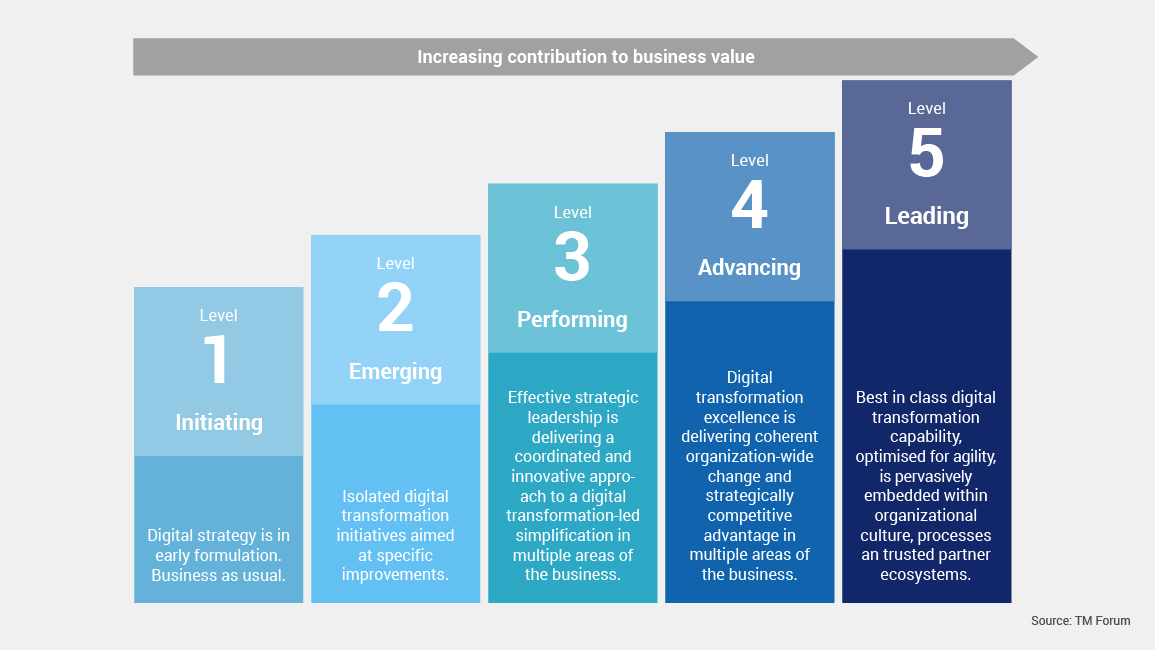The Digital Maturity Model is a powerful tool designed to help organizations navigating through their transformation journey. However, a Digital Maturity Assessment can easily go wrong without keeping certain caveats in mind. As the co-developer of the Digital Maturity Model and a leading expert consultancy in Digital Maturity Assessments, we have summarized three success factors when conducting a Digital Maturity Assessment based on our years of experience. Follow our expert guidance to make the most out of the Digital Maturity Assessment.
Understand the gist of the Digital Maturity Assessment
It would certainly be a big ask for all the participants to understand the Digital Maturity Model and how it works. However, the essence of the assessment itself, which has a significant impact on the quality of the results, is easy to understand and consists of two parts: first, a solid understanding of the maturity levels including their definitions from the participants is needed; second, participants should only answer the questions there are certain of.

We have summarized the maturity levels in the graph above. Every question has five options corresponding to the five maturity levels, the participants should bear in mind that “Performing” level means the criterion asked already delivers overarching value to the organization. That said, the participants should then provide answers to the questions they know of or related to their professional areas, to ensure the accuracy of the results.
Choose the right participants
We found, during deep dive workshops with multiple clients, that the “goodness of fit” of the participants has a strong impact on the quality and the accuracy of the assessment. A poor fit of the participants often results in misleading evaluations, and further affects the direction/ decision-making when developing the corresponding improvement measures. Therefore, it is crucial to choose the right participants for the assessment.
Now you may wonder, what is the “right” way of assigning the participants? To answer this question, we need to focus on the structure of the DMM itself. The DMM consists of six dimensions, covering the whole organizational structure of the company. A mapping of the org structure to the digital maturity dimensions needs to be set up as it allows for the assignment of the right people to the right questions. Then the seniority comes into play. An extensive involvement of senior experts and top management level is highly valuable as the experience and expertise are needed for providing accurate answers.
As the co-developer of the DMM, we have also developed a comprehensive approach based on our years of experience to tailor the model and help our clients to choose the right participants and obtain meaningful assessment results.
Take the questionnaire seriously
It is understandable that people normally do not always taking questionnaires seriously, with the thought of “Yet another meaningless questionnaire….” or “I am only one of the participants, therefore what I answer will not make an impact on the overall results….” However, a serious attitude from each of the participants is a prerequisite for an insightful assessment. The participants’ attitude is reflected in two aspects, the completion rate and the average time spent per question.
Often, we see high participation rate with lower completion rate, despite of the size of the questionnaire. Of course, the lower the completion rate, the lower the explanatory power the assessment results will have, thus low participation rate usually leads to results which are not reflecting the underlying fact. It was also verified during some of the client engagements we had, where a re-assessment was conducted with a strictly specified minimum participation rate to have more realistic results.
Another metric is then the average time spent per question per participant, we ran a quick analysis and found, that the less time one spends per question, the higher one’s results are, also, the lower the standard deviation of the results is. An extreme example coming from a project we did was, that one participant filled all questions with level three, spending two seconds per question on average. This obviously dilutes the usefulness of the assessment results.
Therefore, it is highly recommended to emphasize the discipline before starting the assessment, and what Detecon would always do, is to communicate this message clearly to the management level of our client to gain their support.
Contact us for more insights in Digital Maturity Assessment
You must have realized the importance of an experienced facilitator to what you can get out of a Digital Maturity Assessment. Detecon have had years of experience in Digital Maturity Assessment with active global footprints. Take a look at our service offering one-pager and contact us if you need any advises, we are gladly to help you to get the most out of the Digital Maturity Assessment!







